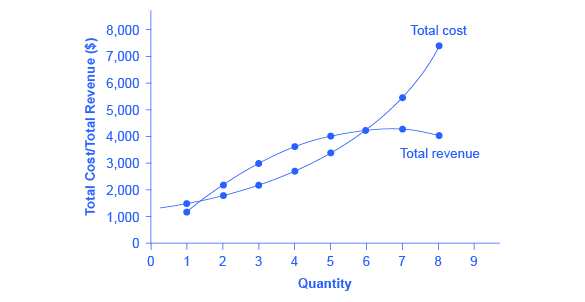| << Chapter < Page | Chapter >> Page > |
While a monopolist can charge any price for its product, that price is nonetheless constrained by demand for the firm’s product. No monopolist, even one that is thoroughly protected by high barriers to entry, can require consumers to purchase its product. Because the monopolist is the only firm in the market, its demand curve is the same as the market demand curve, which is, unlike that for a perfectly competitive firm, downward-sloping.
[link] illustrates this situation. The monopolist can either choose a point like R with a low price (Pl) and high quantity (Qh), or a point like S with a high price (Ph) and a low quantity (Ql), or some intermediate point. Setting the price too high will result in a low quantity sold, and will not bring in much revenue. Conversely, setting the price too low may result in a high quantity sold, but because of the low price, it will not bring in much revenue either. The challenge for the monopolist is to strike a profit-maximizing balance between the price it charges and the quantity that it sells. But why isn’t the perfectly competitive firm’s demand curve also the market demand curve? See the following Clear it Up feature for the answer to this question.
The demand curve as perceived by a perfectly competitive firm is not the overall market demand curve for that product. However, the firm’s demand curve as perceived by a monopoly is the same as the market demand curve. The reason for the difference is that each perfectly competitive firm perceives the demand for its products in a market that includes many other firms; in effect, the demand curve perceived by a perfectly competitive firm is a tiny slice of the entire market demand curve. In contrast, a monopoly perceives demand for its product in a market where the monopoly is the only producer.
Profits for a monopolist can be illustrated with a graph of total revenues and total costs, as shown with the example of the hypothetical HealthPill firm in [link] . The total cost curve has its typical shape; that is, total costs rise and the curve grows steeper as output increases.

| Quantity | Total Cost | Quantity | Price | Total Revenue | Profit = Total Revenue – Total Cost |
|---|---|---|---|---|---|
| 1 | 1,500 | 1 | 1,200 | 1,200 | –300 |
| 2 | 1,800 | 2 | 1,100 | 2,200 | 400 |
| 3 | 2,200 | 3 | 1,000 | 3,000 | 800 |
| 4 | 2,800 | 4 | 900 | 3,600 | 800 |
| 5 | 3,500 | 5 | 800 | 4,000 | 500 |
| 6 | 4,200 | 6 | 700 | 4,200 | 0 |
| 7 | 5,600 | 7 | 600 | 4,200 | –1,400 |
| 8 | 7,400 | 8 | 500 | 4,000 | –3,400 |

Notification Switch
Would you like to follow the 'Principles of economics' conversation and receive update notifications?